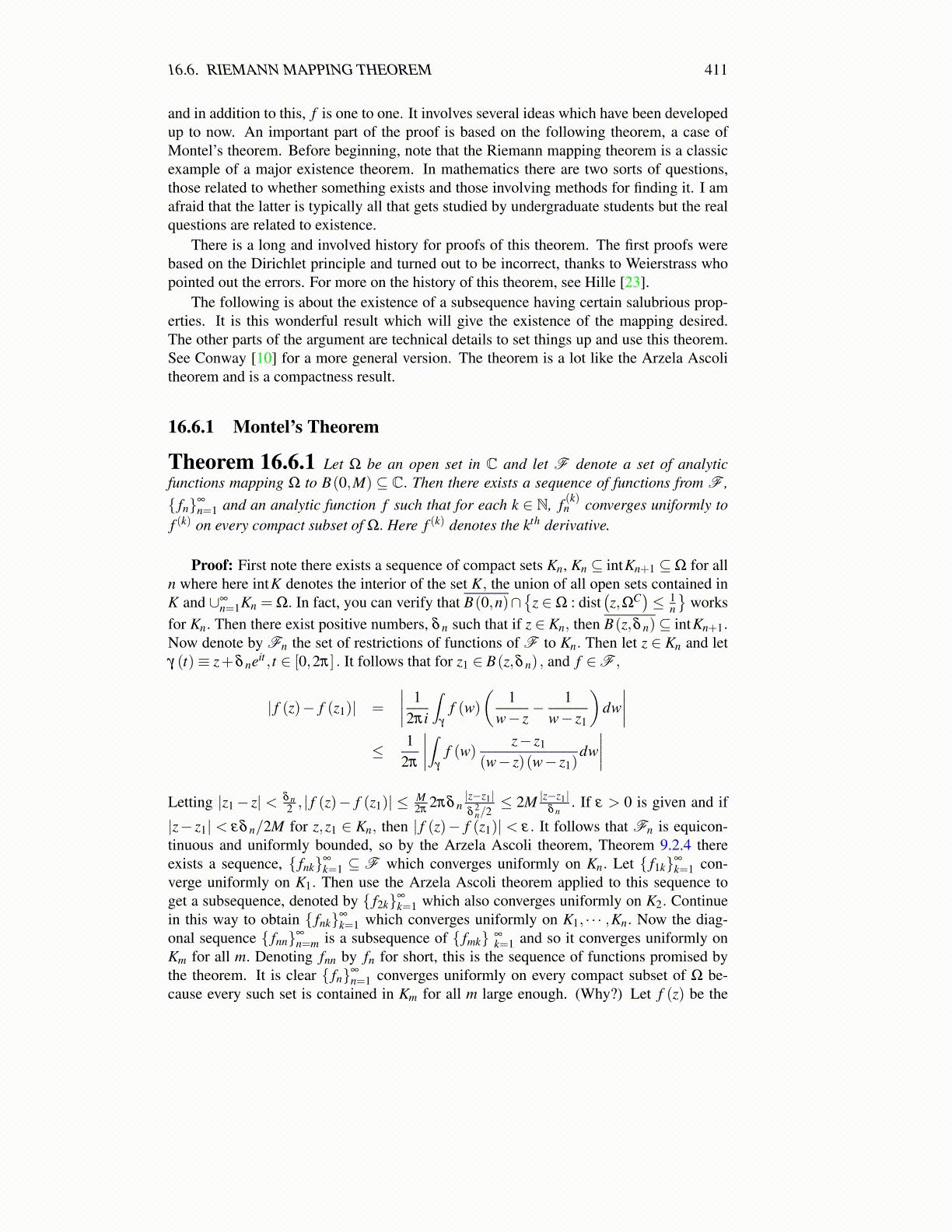
16.6. RIEMANN MAPPING THEOREM 411
and in addition to this, f is one to one. It involves several ideas which have been developedup to now. An important part of the proof is based on the following theorem, a case ofMontel’s theorem. Before beginning, note that the Riemann mapping theorem is a classicexample of a major existence theorem. In mathematics there are two sorts of questions,those related to whether something exists and those involving methods for finding it. I amafraid that the latter is typically all that gets studied by undergraduate students but the realquestions are related to existence.
There is a long and involved history for proofs of this theorem. The first proofs werebased on the Dirichlet principle and turned out to be incorrect, thanks to Weierstrass whopointed out the errors. For more on the history of this theorem, see Hille [23].
The following is about the existence of a subsequence having certain salubrious prop-erties. It is this wonderful result which will give the existence of the mapping desired.The other parts of the argument are technical details to set things up and use this theorem.See Conway [10] for a more general version. The theorem is a lot like the Arzela Ascolitheorem and is a compactness result.
16.6.1 Montel’s Theorem
Theorem 16.6.1 Let Ω be an open set in C and let F denote a set of analyticfunctions mapping Ω to B(0,M) ⊆ C. Then there exists a sequence of functions from F ,{ fn}∞
n=1 and an analytic function f such that for each k ∈ N, f (k)n converges uniformly tof (k) on every compact subset of Ω. Here f (k) denotes the kth derivative.
Proof: First note there exists a sequence of compact sets Kn, Kn ⊆ intKn+1 ⊆Ω for alln where here intK denotes the interior of the set K, the union of all open sets contained inK and ∪∞
n=1Kn = Ω. In fact, you can verify that B(0,n)∩{
z ∈Ω : dist(z,ΩC
)≤ 1
n
}works
for Kn. Then there exist positive numbers, δ n such that if z ∈ Kn, then B(z,δ n)⊆ intKn+1.Now denote by Fn the set of restrictions of functions of F to Kn. Then let z ∈ Kn and letγ (t)≡ z+δ neit , t ∈ [0,2π] . It follows that for z1 ∈ B(z,δ n) , and f ∈F ,
| f (z)− f (z1)| =
∣∣∣∣ 12πi
∫γ
f (w)(
1w− z
− 1w− z1
)dw∣∣∣∣
≤ 12π
∣∣∣∣∫γ
f (w)z− z1
(w− z)(w− z1)dw∣∣∣∣
Letting |z1− z| < δ n2 , | f (z)− f (z1)| ≤ M
2π2πδ n
|z−z1|δ
2n/2≤ 2M |z−z1|
δ n. If ε > 0 is given and if
|z− z1| < εδ n/2M for z,z1 ∈ Kn, then | f (z)− f (z1)| < ε. It follows that Fn is equicon-tinuous and uniformly bounded, so by the Arzela Ascoli theorem, Theorem 9.2.4 thereexists a sequence, { fnk}∞
k=1 ⊆ F which converges uniformly on Kn. Let { f1k}∞
k=1 con-verge uniformly on K1. Then use the Arzela Ascoli theorem applied to this sequence toget a subsequence, denoted by { f2k}∞
k=1 which also converges uniformly on K2. Continuein this way to obtain { fnk}∞
k=1 which converges uniformly on K1, · · · ,Kn. Now the diag-onal sequence { fnn}∞
n=m is a subsequence of { fmk} ∞k=1 and so it converges uniformly on
Km for all m. Denoting fnn by fn for short, this is the sequence of functions promised bythe theorem. It is clear { fn}∞
n=1 converges uniformly on every compact subset of Ω be-cause every such set is contained in Km for all m large enough. (Why?) Let f (z) be the